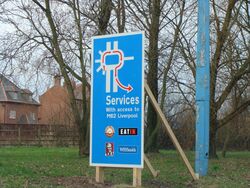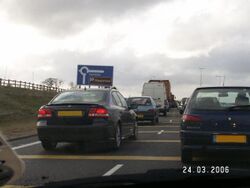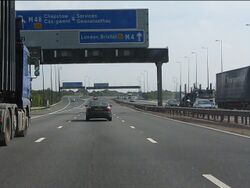Offline services: Difference between revisions
m was in the wrong place |
m randomseed no longer works |
||
| Line 47: | Line 47: | ||
|notcategory = Closed Services | |notcategory = Closed Services | ||
|allowcachedresults = true | |allowcachedresults = true | ||
|notcategory = A-roads | |notcategory = A-roads | ||
|notcategory = Planned Services | |notcategory = Planned Services | ||
Revision as of 21:59, 12 November 2020
An offline service area is one that is not immediately adjacent to the road it is serving, so motorists have to negotiate a junction in order to access it. This design became very common in the late 1980s and 1990s and continues to be seen in proposals today.

Unlike in the UK, in Ireland the phrase "offline services" is used publicly, with road signs saying "offline services available".
Official government-owned services are always of the online type, while private companies can't apply to have a motorway serve their own facility. Instead they can built their own facility at an existing motorway junction, and this gets signposted as a tourist attraction.
UK Experience

For many in the UK, offline services are associated with long queues and complicated roundabouts.
When the first motorways opened, the Ministry of Transport never ruled out the option of building services at a junction, but usually gave way to concerns about traffic at the junction. They also made a point that as most motorway roundabouts were built above the motorway, to bring a service station up to that level would require a significant investment (at the time, the Ministry paid for all the roads within service stations).
At Aust and Scratchwood there were simply no other suitable locations, so those services were allowed to be built at junctions. Gordano and Exeter soon joined this category, but all other services were built in the conventional online style.
By the 1980s, highway engineering policy began to place less emphasis on traffic flow and more on environmental considerations. In addition, many operators had highlighted the point that they preferred services at junctions because they were cheaper to build and run, meaning they would pay more rent.
The opening of the M25 was a turning point for this. In the years leading up to the M25, the Department for Transport had struggled to generate interest in new services. The completion of the M25 was rushed, and it and the surrounding roads needed new services urgently. To avoid battles over green belt land and complicated studies in to how new services would affect traffic flow, almost every service area built during this period was built at a junction. The busier the junction, the better: operators were less hesitant if they knew they'd get a lot of trade.
It was during this period that South Mimms, Birchanger Green and Thurrock were designed, three of the most controversial services in terms of traffic congestion.
This became even more common after 1992, when services became privately planned. Developers almost exclusively considered junction sites because they were much cheaper to build.
In 2008, the Highways Agency put a stop to this, by saying no more services should be built at junctions unless there is no other option available. In 2013, their wording was weakened, and they simply said that if there were two otherwise identical proposals, they would prefer the online option.
Variations
Burtonwood and Northampton can both be regarded as offline services, but they started out as online ones: they had a motorway junction built around them.
There is a third design which falls into neither category, where the services take the design of an offline service area but are accessed via their own junction. This is an expensive attempt to get the best of both, with Cobham being the most well-known.
Offline Services
This lists motorway services recognised by Transport Infrastructure Ireland only.
- Mayfield (M7 at J14)
- Fermoy (M8 at J14)
- Birdhill (M7 at J27)
- Manor Stone (M8 at J3)
- Paulstown (M9 at J7)
- Carlow (M9 at J5)
- Galway (M6 at J16)
- Cashel (M8 at J8)
- Moneygall (M7 at J23)
- Wicklow (M11 at J14)
Longest Drives

Having to do a long drive from the motorway to the service area itself is a common complaint from road users.
Below we have listed some of the worst offenders. There will be more service stations which may be frustrating to get to, but don't out-rank these in any category. You can tap the 'sort' buttons to find the worst offender in each category.
The 'distance' is measured from the motorway exit to the service area entrance. The 'impact on journey' compares the effect of visiting the service area with staying on the motorway. 'Traffic lights' counts the number of sets of traffic lights on the route in, including those on roundabouts and part-time signals. 'Roundabouts' only looks at the route into the service area.
A service area with a high 'distance' but low 'impact' may feel like it's far away, but it doesn't really affect your journey. A service area with a low 'distance' but high 'impact' may be easy to get in to, but hard to get out of. Only services which are signed at motorway exits are included, including a few dubious examples.
| Service Area | Maximum Distance From Motorway | Maximum Impact On A Journey | Traffic Lights | Roundabouts | Notes |
|---|---|---|---|---|---|
| Severn View | 9.7 miles (from M4 eastbound) | 2.5 miles (to & from M4 westbound) | 0 | 1 | It's not really an M4 service area. Distance is on a motorway so it doesn't add much time. |
| Lymm | 1.5 miles (from M56 westbound) | 2.3 miles (to & from M56 westbound) | 1 | 2 | It's actually a truckstop. Complex interchange, mostly motorway so it doesn't add much time. |
| Leeming Bar | 1.3 miles (from A1(M) southbound) | 2.1 miles (to & from A1(M) southbound) | 0 | 3 | The road junction was moved much further away. Distance is mostly on a fast road. |
| Thurrock | 1.1 miles (from M25 clockwise) | 1.6 miles (to & from M25 anti-clockwise) | 4 | 2 | DoT decision to build here. |
| Scotch Corner | 0.6 miles (from A1(M) northbound) | 1.3 miles (to & from A1(M) northbound) | 4 | 1 | |
| South Mimms | 1.0 miles (from M25 clockwise) | 1.2 miles (to & from M25 clockwise) | 6 | 2 | DoT decision to use this site. |
| Burtonwood | 0.7 miles (from M62 westbound) | 1.1 miles (to & from M62 westbound) | 5 | 1 | Used to be direct access, then the two sides were merged. |
| Exeter | 0.8 miles (from M5 southbound) | 1.0 miles (to & from M5 southbound) | 8 | 2 | DoT decision to build here. |
| Tamworth | 0.8 miles (from M42 southbound) | 0.8 miles (to & from M42 southbound) | 5 | 2 | DfT took years and decided this was where they wanted it. |
| Ferrybridge | 2.1 miles (from A1(M) southbound) | 0.8 miles (to & from A1(M) northbound) | 0 | 1 | Not really an A1(M) service area. |
| Donington | 2.4 miles (from M1 southbound) | 0.7 miles (to & from M1 southbound) | 6 | 2 | |
| Beaconsfield | 0.7 miles (from M40 southbound) | 0.7 miles (to & from M40 southbound) | 4 | 2 |
In some respects this list is slightly unfair. A high mileage isn't so bad if it's on a fast road, like with Severn View or Lymm. Likewise traffic lights aren't a problem if they're all green. What really matters is journey time, but that's way too variable to record here.